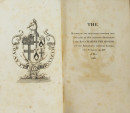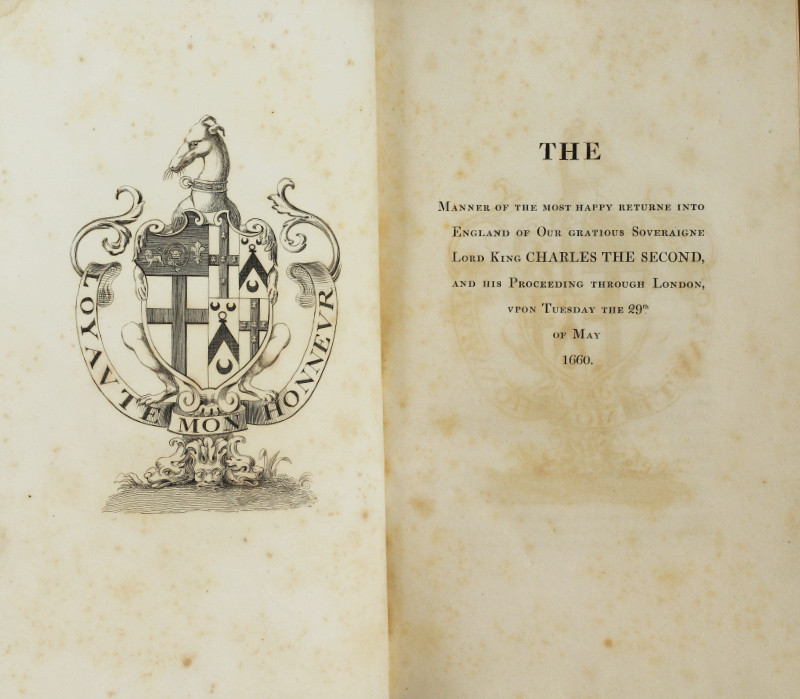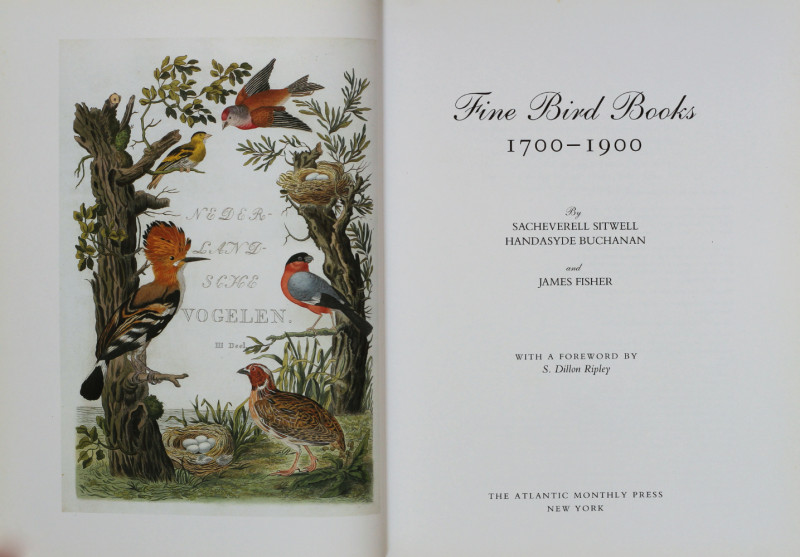A Circumstantial Account of the Preparations for the Coronation of His Majesty King Charles the Second...






Book Description
A ‘VERY MINUTE’ ACCOUNT OF THE CORONATION OF CHARLES II AT WESTMINSTER ABBEY, FROM SIR THOMAS PHILLIPPS’S CELEBRATED MIDDLE HILL LIBRARY
Full title: A Circumstantial Account of the Preparations for the Coronation of His Majesty King Charles the Second, and A Minute Detail of that Splendid Ceremony with all the Particulars Connected with it; Including the Installation of Knights, Creation of Peers, &c. To which is Prefixed, An Account of the Landing, Reception, and Journey of His Majesty from Dover to London. From an Original Manuscript, by Sir Edward Walker, Knight, Garter Principal King at Arms at that Period
Octavo (239 x 145mm), pp. 131, [1 (imprint)]. Engraved plate of Walker’s arms and 9 engraved or aquatint plates. 2 facsimiles in the text, one full-page. (Some light spotting and offsetting, very light damp-marking at upper margins of some ll. and plates.) 19th-century British calf gilt, boards with borders of double gilt rules, spine lettered directly in gilt and decorated in gilt, board-edges roll-tooled in blind, mid-brown endpapers, all edges speckled red. (Some light marking, extremities rubbed and bumped, boards scuffed.) A very good copy.
Provenance: [?Joseph Lilly, London (1804-1870; acquired in 1850 by:)] – Sir Thomas Phillipps Bt, Middle Hill Library (1792-1872, inscription ‘M[iddle].H[ill].C[atalogue].’ on upper pastedown with further note ‘Lilly 50’) and pressmark ‘XXVIII.d.10’ on front free endpaper; traces of removed paper label on lower board; by descent to his grandson:) – Thomas FitzRoy Fenwick (1856-1938, under whose ownership the sales of Phillipps’s library took place) – Stanley Kelly (1912-2001, and by descent).
Full title: A Circumstantial Account of the Preparations for the Coronation of His Majesty King Charles the Second, and A Minute Detail of that Splendid Ceremony with all the Particulars Connected with it; Including the Installation of Knights, Creation of Peers, &c. To which is Prefixed, An Account of the Landing, Reception, and Journey of His Majesty from Dover to London. From an Original Manuscript, by Sir Edward Walker, Knight, Garter Principal King at Arms at that Period
Octavo (239 x 145mm), pp. 131, [1 (imprint)]. Engraved plate of Walker’s arms and 9 engraved or aquatint plates. 2 facsimiles in the text, one full-page. (Some light spotting and offsetting, very light damp-marking at upper margins of some ll. and plates.) 19th-century British calf gilt, boards with borders of double gilt rules, spine lettered directly in gilt and decorated in gilt, board-edges roll-tooled in blind, mid-brown endpapers, all edges speckled red. (Some light marking, extremities rubbed and bumped, boards scuffed.) A very good copy.
Provenance: [?Joseph Lilly, London (1804-1870; acquired in 1850 by:)] – Sir Thomas Phillipps Bt, Middle Hill Library (1792-1872, inscription ‘M[iddle].H[ill].C[atalogue].’ on upper pastedown with further note ‘Lilly 50’) and pressmark ‘XXVIII.d.10’ on front free endpaper; traces of removed paper label on lower board; by descent to his grandson:) – Thomas FitzRoy Fenwick (1856-1938, under whose ownership the sales of Phillipps’s library took place) – Stanley Kelly (1912-2001, and by descent).
Dealer Notes
First edition. Born in Somerset, Sir Edward Walker (1612-1677) entered the service of Thomas Howard, Earl of Arundel in 1633, and, thanks to Arundel’s patronage, Walker was appointed Blanch Lyon Pursuivant-Extraordinary in 1635 – his first position as an Officer of Arms. In 1637 Walker was appointed Rouge Dragon Pursuivant, then Chester Herald in the following year, and began to undertake political and administrative roles. On 22 April 1642, shortly before the Civil War broke out, Charles I sent Walker and another herald to demand the surrender of Kingston-upon-Hull, and in the autumn of 1642 Walker became the king’s Secretary at War, settling in Oxford in 1642, where he remained until the city surrendered in 1646. At Oxford, Walker was appointed Norroy King of Arms in 1644, was knighted on 2 January 1645, and became Garter King of Arms later in 1645. After a brief exile in France following the defeat of the King in 1646, Walker returned to join Charles I on the Isle of Wight, where the king was imprisoned from 1647-1648, but after the trial and execution in 1649 of Charles I, Walker joined his son, the exiled Charles II, in the Hague. In 1650 Walker travelled to Scotland with the new king, but returned to Holland later in the year and spent much of the following five years in the country, before joining Charles II at Cologne in 1655, where Walker was appointed Secretary of the Council and, the following year, Secretary at War. Upon the Restoration in 1660 Walker returned to England, where he took up the role of Garter King of Arms once more (Edward Bysshe had, with the support of Parliament, held it from 1646 to 1660).
Walker played an important part in the coronation of Charles II at Westminster Abbey on 23 April 1661, and shortly afterwards wrote his account of the ceremony in a 52ll. manuscript dated 25 May 1661. The present book was, according to the editor, ‘printed verbatim from the original manuscript’ (p. [3]), and provides a ‘very minute’ account of the coronation ‘containing every particular connected with it’ (Moule). This account is preceded by an account of the King’s return in 1660, details of the ceremonies and events which welcomed the returning monarch, a description of the regalia and ornaments used during the ceremony (some of which are illustrated), narratives of the ceremonies to create peers and Knights of the Bath, and an account of the monarch’s procession from the Tower of London to Whitehall the day before the coronation.
This copy of A Circumstantial Account is from the celebrated library Sir Thomas Phillipps formed at Middle Hill, the estate he inherited from his father in 1818. Phillipps had already acquired a collection of 110 volumes by the age of 16, and, with an income of £6,000 per annum following his father’s death, Phillipps ‘set about buying books and manuscripts with gusto, copying and commissioning transcripts of historical documents, and from 1822 having them printed, usually coarsely and in small quantities, by a succession of his own printers on a private press’ (ODNB). The extravagance of Phillipps’s purchases led him to live on the Continent during the 1820s in order to economise – which proved difficult, since ‘the French Revolution, the Napoleonic wars, and the secularization of the German monastic houses in 1803’ meant that ‘old books and manuscripts were more widely available than at any time before or since’ (op. cit.). The pace of acquisition continued through Phillipps’s life as he assembled a remarkable collection at Middle Hill, which necessitated a move (due to lack of space) to Thirlestaine House, Cheltenham in 1863 (as the ODNB notes, it ‘took two years for a wagon train to transport the library across the Cotswolds to its new home’).
The note ‘Lilly 50’ inside this copy suggests that Phillipps purchased it from the London bookseller Joseph Lilly in 1850. Lilly, who had been born in Birmingham, moved to London to serve an apprenticeship with Lackington, before establishing his own business at 5 Museum Street, Bloomsbury in 1831 (he would later have premises in Covent Garden and Pall Mall). F.S. Ellis characterised Lilly as ‘a man of great force of character, combative, aggressive, and brusque to a degree which not infrequently bordered on rudeness; frugal to the point where frugality and parsimony are near neighbours, while his threadbare black suit and much-worn hat caused him to run the risk of being looked upon as a person of decidedly slovenly habits. He was, however, a man of kindly heart, though careful of his self-interest; and what was more to the point, with a very considerable knowledge of English books, and an instinctive appreciation of many of those in foreign languages, albeit he understood not a word of them’ (quoted in A.N.L. Munby, Phillipps Studies No. 4: The Formation of the Phillipps Library from 1841 to 1872 (Cambridge, 1956), p. 4). Munby writes that Lilly ‘had a large share in the formation of the library of Henry Huth, and it has been claimed that he bought and sold more copies of the First Folio of Shakespeare than any other bookseller. His relations with Phillipps were unusually cordial’ (loc. cit.). Phillipps seems to have been a client of Lilly’s since the 1840s, and the bookseller continued ‘to do a good deal of business with Phillipps’ during the following decade (op. cit., p. 65). Assuming that this volume was purchased from Lilly in 1850, it would have formed part of the Middle Hill Library before it was relocated to Cheltenham in the following decade.
After Phillipps’s death the vast collections were dispersed, initially through a series of 22 auctions, before the ‘still vast residue’ (ODNB) was purchased by the London booksellers Lionel and Philip Robinson in 1947, who sold some of the books and manuscripts through their own business and a series of auctions at Sotheby’s, before selling the remainder en bloc to the American bookseller H.P. Kraus in 1977. It seems most likely that this volume was sold from the Phillipps library in Britain, since it was subsequently in the collection of the British book collector and audio engineer Stanley Kelly, who had worked on the development of radar during World War II, before establishing himself as one of the leading British audio engineers of the post-war era and co-founding the periodical Hi-Fi News & Record Review in 1956.
H. and M. Hiler, Bibliography of Costume, p. 890; Lowndes, p. 2811; Moule, Bibliotheca Heraldica Magnae Britanniae, DCCCIV.
--
Please contact us with any enquiries. Or, if you prefer, order this book directly from our website (www.typeandforme.com).
Walker played an important part in the coronation of Charles II at Westminster Abbey on 23 April 1661, and shortly afterwards wrote his account of the ceremony in a 52ll. manuscript dated 25 May 1661. The present book was, according to the editor, ‘printed verbatim from the original manuscript’ (p. [3]), and provides a ‘very minute’ account of the coronation ‘containing every particular connected with it’ (Moule). This account is preceded by an account of the King’s return in 1660, details of the ceremonies and events which welcomed the returning monarch, a description of the regalia and ornaments used during the ceremony (some of which are illustrated), narratives of the ceremonies to create peers and Knights of the Bath, and an account of the monarch’s procession from the Tower of London to Whitehall the day before the coronation.
This copy of A Circumstantial Account is from the celebrated library Sir Thomas Phillipps formed at Middle Hill, the estate he inherited from his father in 1818. Phillipps had already acquired a collection of 110 volumes by the age of 16, and, with an income of £6,000 per annum following his father’s death, Phillipps ‘set about buying books and manuscripts with gusto, copying and commissioning transcripts of historical documents, and from 1822 having them printed, usually coarsely and in small quantities, by a succession of his own printers on a private press’ (ODNB). The extravagance of Phillipps’s purchases led him to live on the Continent during the 1820s in order to economise – which proved difficult, since ‘the French Revolution, the Napoleonic wars, and the secularization of the German monastic houses in 1803’ meant that ‘old books and manuscripts were more widely available than at any time before or since’ (op. cit.). The pace of acquisition continued through Phillipps’s life as he assembled a remarkable collection at Middle Hill, which necessitated a move (due to lack of space) to Thirlestaine House, Cheltenham in 1863 (as the ODNB notes, it ‘took two years for a wagon train to transport the library across the Cotswolds to its new home’).
The note ‘Lilly 50’ inside this copy suggests that Phillipps purchased it from the London bookseller Joseph Lilly in 1850. Lilly, who had been born in Birmingham, moved to London to serve an apprenticeship with Lackington, before establishing his own business at 5 Museum Street, Bloomsbury in 1831 (he would later have premises in Covent Garden and Pall Mall). F.S. Ellis characterised Lilly as ‘a man of great force of character, combative, aggressive, and brusque to a degree which not infrequently bordered on rudeness; frugal to the point where frugality and parsimony are near neighbours, while his threadbare black suit and much-worn hat caused him to run the risk of being looked upon as a person of decidedly slovenly habits. He was, however, a man of kindly heart, though careful of his self-interest; and what was more to the point, with a very considerable knowledge of English books, and an instinctive appreciation of many of those in foreign languages, albeit he understood not a word of them’ (quoted in A.N.L. Munby, Phillipps Studies No. 4: The Formation of the Phillipps Library from 1841 to 1872 (Cambridge, 1956), p. 4). Munby writes that Lilly ‘had a large share in the formation of the library of Henry Huth, and it has been claimed that he bought and sold more copies of the First Folio of Shakespeare than any other bookseller. His relations with Phillipps were unusually cordial’ (loc. cit.). Phillipps seems to have been a client of Lilly’s since the 1840s, and the bookseller continued ‘to do a good deal of business with Phillipps’ during the following decade (op. cit., p. 65). Assuming that this volume was purchased from Lilly in 1850, it would have formed part of the Middle Hill Library before it was relocated to Cheltenham in the following decade.
After Phillipps’s death the vast collections were dispersed, initially through a series of 22 auctions, before the ‘still vast residue’ (ODNB) was purchased by the London booksellers Lionel and Philip Robinson in 1947, who sold some of the books and manuscripts through their own business and a series of auctions at Sotheby’s, before selling the remainder en bloc to the American bookseller H.P. Kraus in 1977. It seems most likely that this volume was sold from the Phillipps library in Britain, since it was subsequently in the collection of the British book collector and audio engineer Stanley Kelly, who had worked on the development of radar during World War II, before establishing himself as one of the leading British audio engineers of the post-war era and co-founding the periodical Hi-Fi News & Record Review in 1956.
H. and M. Hiler, Bibliography of Costume, p. 890; Lowndes, p. 2811; Moule, Bibliotheca Heraldica Magnae Britanniae, DCCCIV.
--
Please contact us with any enquiries. Or, if you prefer, order this book directly from our website (www.typeandforme.com).
Author
WALKER, Sir Edward
Date
1820
Publisher
London: Thomas Davison for T. Baker
Friends of the PBFA
For £10 get free entry to our fairs, updates from the PBFA and more.
Please email info@pbfa.org for more information













